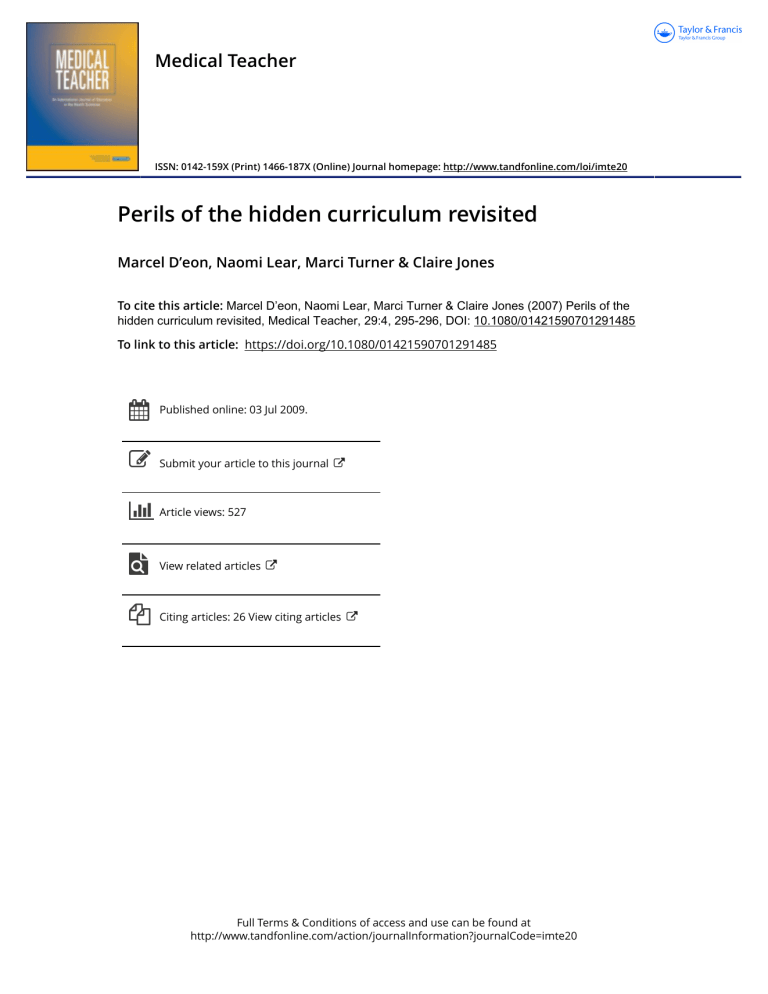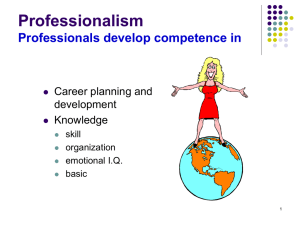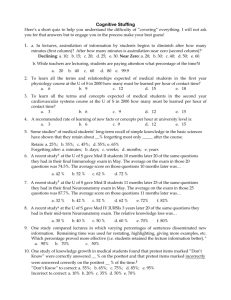Perils of the hidden curriculum revisited
advertisement

Medical Teacher ISSN: 0142-159X (Print) 1466-187X (Online) Journal homepage: http://www.tandfonline.com/loi/imte20 Perils of the hidden curriculum revisited Marcel D’eon, Naomi Lear, Marci Turner & Claire Jones To cite this article: Marcel D’eon, Naomi Lear, Marci Turner & Claire Jones (2007) Perils of the hidden curriculum revisited, Medical Teacher, 29:4, 295-296, DOI: 10.1080/01421590701291485 To link to this article: https://doi.org/10.1080/01421590701291485 Published online: 03 Jul 2009. Submit your article to this journal Article views: 527 View related articles Citing articles: 26 View citing articles Full Terms & Conditions of access and use can be found at http://www.tandfonline.com/action/journalInformation?journalCode=imte20 2007; 29: 295–296 COMMENTARY Perils of the hidden curriculum revisited* MARCEL D’EON1, NAOMI LEAR2, MARCI TURNER3 & CLAIRE JONES3 1 University of Saskatchewan, Canada, 2McGill University, Canada, 3University of Western Ontario, Canada Abstract Medical schools are beginning to better define, teach, and assess professionalism for students. While there are many positive aspects of medical school training some students encounter poor modeling, unresolved ethical dilemmas, unnecessary and debilitating academic stresses, and emotional and physical harassment. This may undermine current trend to create programs that develop professionalism in students. In Canada and around the world, medical schools are beginning to better define, teach, and assess professionalism. The value of doing so for students has recently and persuasively been argued by Cruess & Cruess (2006). There is also a growing awareness of the ‘hidden curriculum’ (Hundert et al. 1996; Kassebaum & Cutler 1998; Crook et al. 2004; Caldicott & Faber-Langendoen 2005); that is, the learning students derive from the ‘‘nature and organizational design [of a program], as well as from the behaviors and attitudes of teachers and administrators’’ (Longstreet & Shane 1993, p. 46). Although we acknowledge that, for the most part, the medicalschool experience is positive, it is the goal of this commentary to focus on those interactions within the hidden curriculum that require our earnest attention (Coulehan & Williams 2001). For instance, students encounter ethical challenges that they are unable to resolve, due to a lack of guidance or to negative modeling, and are often left feeling inadequate and unintelligent (Turner et al. 2006; Lear and Tellier 2006a). Additionally, far too many students do not report adverse situations and incidents (Department of Medical Education 2004; Sokol 2004). In this commentary, we describe ways in which certain aspects of the hidden curriculum—specifically, emotional stress created by exposure to unethical behavior, unreasonable academic requirements, and harassment by supervising physicians—subvert the professional behaviors educators want to teach. We contend that it makes little sense for medical schools to rigorously teach and evaluate professionalism for students when the destructive elements of the hidden curriculum are allowed to go unchecked (Kassebaum & Cutler 1998). The way we treat medical students is the way they will treat their patients, colleagues, and future medical students: medical students will do what we do, not what we say (Kassebaum & Cutler 1998). Professionalism is threatened when medical students are forced by attending physicians to choose between the role of learner and the role of health-care provider (Hicks et al. 2001). Most ‘professional lapses’ identified by medical students fall into one of three categories: conflict between education and patient care; professional responsibility exceeding capability; and substandard patient care (Hicks et al. 2001). Inspired by their own experiences of facing ethical dilemmas, a team of Canadian medical students collected narratives from upperyear students that described experiences where they felt their duty to learn conflicted with their duty to treat (Turner et al. 2006). They reported a number of troubling situations. For example, attending physicians sometimes did not obtain patient consent for student involvement in patient care (often when patients were under anesthesia), or exaggerated a student’s competency to obtain such consent. A number of students described feeling insecure and under-prepared to assume the tasks assigned to them by their supervisors; this caused them anxiety about their ability to provide high-quality patient care, and about the possibility of causing patient harm while learning new technical procedures. In general, students were concerned when their involvement in patient care may have compromised the patient’s dignity, comfort, or convenience, or when patients seemed to be ‘used’ for educational purposes (even if they had consented to student participation in their care). Furthermore, students often suppressed their own opinions about patient care, ethics, and medical management to avoid the consequences of questioning an authority figure. In addition to presenting ethical dilemmas, the hidden curriculum may undermine the teaching of professionalism by unintentionally undermining feelings of self-efficacy and decreasing the value of the patient–physician relationship (Pololi & Price 2000). One of the authors of this article encounters two or three medical students per year who seek him out for advice regarding academic difficulty. These students were typically very successful in their earlier academic pursuits and continue to work diligently, yet perform poorly because of their lack of preparation for the sciences. These students seriously question their abilities. As they chose pre-medical courses and programs other than the basic medical sciences, these students struggle to learn in medical school the content that is expected of them, some of which is Correspondence: Marcel D’Eon, Educational Support and Development, B103 Health Sciences Building, 107 Wiggins Road, Saskatoon, SK, S7J156. Email: marcel.dean@usask.ca *This commentary is provided by the Canadian Association of Medical Education (CAME). ISSN 0142–159X print/ISSN 1466–187X online/07/040295–2 ß 2007 Informa UK Ltd. DOI: 10.1080/01421590701291485 295 D’Eon et al. not relevant or helpful for future practice (D’Eon & Crawford 2005). These students wonder if they are less capable than their peers, and they worry that they will not be ‘good doctors’ when they finish medical school. We need to recognize the toll that an overcrowded curriculum and a lack of support takes on our students. When students’ strengths are not emphasized, and students are belittled for their lack of knowledge (Lear & Tellier 2006a), their self-esteem and motivation to learn are affected (Lear 2006), with far-reaching consequences. To correct this situation, we suggest that students should be trained to recognize their own negative thought patterns, identify sources of academic difficulty, and use academic and psychological strategies to study more effectively and to deal with lower-than-desired assessment results. Faculty, for its part, needs to adopt an approach that focuses more on student learning: it should identify the sources of academic challenges, make changes to courses based on sound pedagogical principles (including, but not limited to, managing the amount of content), and develop ways to recognize and build on the strengths of the individual students in their programs. We know that negative experiences of professional behavior, unnecessary academic stress, and the harassment of students are all prevalent, with significant consequences for both students and patients (Department of Medical Education 2004). When students do not bring their concerns forward, they risk excusing unethical and inappropriate practice in the future (Satterwhite et al. 2000; Goldie 2004). Despite this, less than a third of American medical students report harassment to administrators who are empowered to respond to such complaints (Department of Medical Education 2004). It was for this reason that a Canadian undergraduate medical student surveyed clinical clerks about their experiences of harassment during medical training. In this qualitative pilot project, students described incidents of mistreatment they had experienced, barriers they encountered in reporting this harassment, and factors they believed would facilitate reporting (Lear & Tellier 2006b). Examples of harmful incidents reported by those students include the misuse of power, inadequate preparation for procedures, discrimination, and assault. Barriers to reporting mistreatment included the belief that harassment is an expected part of medical training, a lack of education on the part of students and faculty about what constitutes harassment and about the mechanisms available for responding to it, and a fear of retaliation, associated with the lack of an anonymous reporting process. The students suggested several strategies to combat harassment: increasing awareness among students and staff about the role of medical students and the responsibilities for personal conduct; creating student support groups; developing multiple options for reporting; and providing protections for ‘whistle-blowers’. Turner et al. (2006) recommend that clinical instructors be aware of moral teaching practice guidelines that relate to specific ethical challenges faced by medical students, particularly those situations in which their professional responsibilities are in conflict. Although there are many positive aspects of the early clinical experiences (Dornan & Bundy 2004) and academic 296 training of medical students, this article has highlighted some areas of the hidden curriculum which must be addressed. As described above, some Canadian students encounter poor modeling, unresolved ethical dilemmas, unnecessary and debilitating academic stress, and emotional and physical harassment. A lack of attention to these problems undermines the current trend in medical education of creating programs that develop professionalism in students (Cruess & Cruess 2006; Kassebaum & Cutler 1998). In the same way that we are becoming more sophisticated in formally and consciously teaching and evaluating professionalism for students, we must become more serious about neutralizing and reversing the pernicious elements of the hidden curriculum. References Caldicott CV, Faber-Langendoen K. 2005. Deception, discrimination, and fear of reprisal: lessons in ethics from third-year medical students. Acad Med 80:866–873. Coulehan L, Williams PC. 2001. Vanquishing virtue: the impact of medical education. Acad Med 76:598–605. Crook ED, Stellini M, Levine D, Wiese W, Douglas S. 2004. Medical errors and the trainee: ethical concerns. Am J Med Sci 327:33–37. Cruess RL, Cruess SR. 2006. Teaching professionalism: general principles. Med Teach 28:205–208. D’Eon M, Crawford R. 2005. The elusive content of the medical-school curriculum: a method to the madness. Med Teach 27:699–703. Department of Medical Education. 2004. AAMC graduation questionnaire: all schools report. Available at: http://www.aamc.org/data/gq/ allschoolsreports/start.htm (accessed 24 May 2007). Dornan T, Bundy C. 2004. What can experience add to early medical education? Consensus survey. Br Med J 329:834–838. Goldie JGS. 2004. The detrimental ethical shift toward cynicism: can medical educators prevent it? Med Educ 38:232–234. Hicks LK, Lin Y, Robertson DW, Robinson DL, Woodrow SI. 2001. Understanding the clinical dilemmas that shape medical students’ ethical development: questionnaire survey and focus group study. Br Med J 322:709–710. Hundert EM, Hafferty F, Christakis D. 1996. Characteristics of the informal curriculum and trainees’ ethical choices. Acad Med 71:624–633. Kassebaum DG, Cutler ER. 1998. On the culture of student abuse in medical school. Acad Med 73:1149–1158. Lear ND. 2006. Lessons for doctors from Jewish philosophy. Br Med J 332:311. Lear ND & Tellier P-P. (2006a). A qualitative study of medical students’ well-being, coping behaviors, and ideas for health promoting interventions. Poster presented at the Canadian Medical Education Conference; 2006 Apr 29–May 2; London ON, Canada. Lear ND & Tellier P-P. (2006b). A qualitative pilot study of barriers to reporting & factors enabling the reporting of harassment by medical students. Poster presented at the Canadian Medical Education Conference; 2006 Apr 29–May 2; London ON, Canada. Longstreet WS, Shane HG. 1993. Curriculum for a new millennium (Boston, Allyn and Bacon). Pololi L, Price J. 2000. Validation and use of an instrument to measure the learning environment as perceived by medical students. Teach Learn Med 12:201–207. Satterwhite RC, Satterwhite III, WM, Enarson C. 2000. An ethical paradox: the effect of unethical conduct on medical students’ values. J Med Ethics 26:462–465. Sokol DK. 2004. How to be a ‘‘good’’ medical student. J Med Ethics 30:612. Turner M, Jones C, Ascai M, Costescu D, Puente S & Wilson T. (2006). Duty to learn vs. duty to treat: the medical student’s professional responsibility. Poster presented at the Canadian Medical Education Conference; 2006 Apr 29–May 2; London ON, Canada.


